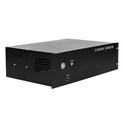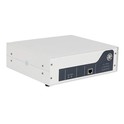Can an Ultrasonic Tank Filter be Used in Large - Scale Industrial Tanks?
As a supplier of ultrasonic tank filters, I often encounter inquiries about the applicability of our products in large - scale industrial tanks. This blog aims to explore this question in depth, considering the unique features of ultrasonic tank filters and the specific requirements of large - scale industrial operations.
Understanding Ultrasonic Tank Filters
First, let's understand what an ultrasonic tank filter is. An Ultrasonic Tank Filter combines the principles of ultrasonic technology and traditional filtration. Ultrasonic waves are used to enhance the filtration process by creating cavitation bubbles. These bubbles implode near the surface of the filter media, dislodging particles that might otherwise clog the filter. This self - cleaning mechanism helps to maintain the filter's efficiency over time.
The ultrasonic tank filter consists of a filter housing, filter media, and an ultrasonic transducer. The filter media can be made of various materials such as stainless steel, ceramic, or synthetic fibers, depending on the type of contaminants to be removed. The ultrasonic transducer generates high - frequency sound waves that are transmitted through the liquid in the tank.
Advantages of Ultrasonic Tank Filters
One of the main advantages of ultrasonic tank filters is their ability to provide continuous and efficient filtration. In large - scale industrial tanks, where a constant supply of clean liquid is crucial, the self - cleaning feature of ultrasonic tank filters ensures that the filtration process is not interrupted by clogging. This can lead to significant savings in terms of maintenance time and costs.
Another advantage is the high level of filtration precision. Ultrasonic tank filters can remove a wide range of contaminants, including fine particles, oil droplets, and even some microorganisms. This makes them suitable for industries such as food and beverage, pharmaceuticals, and electronics manufacturing, where strict quality control of the liquid medium is required.
In addition, ultrasonic tank filters are relatively compact and can be easily integrated into existing tank systems. They do not require large amounts of additional space, which is often a constraint in large - scale industrial facilities.
Challenges in Large - Scale Industrial Applications
However, there are also some challenges when considering the use of ultrasonic tank filters in large - scale industrial tanks. One of the main challenges is the power requirement. Ultrasonic transducers need a certain amount of power to generate effective cavitation. In large - scale tanks, the volume of liquid is much larger, which means that more powerful ultrasonic transducers may be needed to cover the entire tank volume. This can increase the energy consumption and operating costs.


Another challenge is the distribution of ultrasonic waves. In a large tank, it can be difficult to ensure that the ultrasonic waves are evenly distributed throughout the liquid. Uneven distribution may result in some areas of the tank having insufficient cavitation, which can lead to incomplete filtration in those areas.
Solutions to Overcome Challenges
To address the power requirement issue, we can design multi - transducer systems. By using multiple smaller ultrasonic transducers strategically placed in the tank, we can achieve a more uniform distribution of ultrasonic energy while reducing the overall power consumption. This approach also allows for better control of the ultrasonic field in different parts of the tank.
To solve the problem of ultrasonic wave distribution, advanced simulation and modeling techniques can be used during the design phase. These techniques can help us predict the propagation of ultrasonic waves in the tank and optimize the placement of the transducers. In addition, we can also use flow - control devices to ensure that the liquid in the tank is flowing in a way that promotes better distribution of the ultrasonic waves.
Case Studies
Let's look at some real - world examples of the use of ultrasonic tank filters in large - scale industrial tanks. In a large - scale food processing plant, an ultrasonic tank filter was installed in a fermentation tank. The filter was able to continuously remove impurities from the fermentation broth, ensuring the quality of the final product. The self - cleaning feature of the filter reduced the need for frequent manual cleaning, which saved a significant amount of time and labor costs.
In an electronics manufacturing facility, an ultrasonic tank filter was used in a chemical plating tank. The high - precision filtration provided by the filter helped to prevent the deposition of contaminants on the electronic components, improving the yield and quality of the products.
Comparison with Other Filtration Methods
When compared with other filtration methods commonly used in large - scale industrial tanks, such as sand filters and cartridge filters, ultrasonic tank filters have some distinct advantages. Sand filters are relatively simple and inexpensive, but they require frequent backwashing to remove the accumulated contaminants. Cartridge filters, on the other hand, need to be replaced regularly, which can be costly.
In contrast, ultrasonic tank filters offer continuous filtration without the need for frequent backwashing or cartridge replacement. Their self - cleaning mechanism extends the service life of the filter media, making them a more cost - effective solution in the long run.
However, it's important to note that in some cases, a combination of different filtration methods may be the best approach. For example, an ultrasonic tank filter can be used in conjunction with a pre - filter to remove larger particles before the liquid enters the main filtration system. This can further enhance the overall filtration efficiency.
Considerations for Different Industries
Different industries have different requirements when it comes to the use of ultrasonic tank filters in large - scale industrial tanks. In the oil and gas industry, for example, the main concern is the removal of solid particles and oil droplets from the produced water. Ultrasonic tank filters can be designed to handle high - flow rates and high - concentration contaminants in this context.
In the pharmaceutical industry, strict regulatory requirements regarding the purity of the liquid medium need to be met. Ultrasonic tank filters can be customized with high - grade filter media and specific ultrasonic frequencies to ensure the removal of even the smallest contaminants, such as bacteria and viruses.
Conclusion
In conclusion, an ultrasonic tank filter can be used in large - scale industrial tanks, but it requires careful consideration of the specific requirements and challenges of each application. With proper design and engineering, the advantages of ultrasonic tank filters, such as continuous filtration, high precision, and self - cleaning, can be fully utilized in large - scale industrial settings.
If you are interested in exploring the use of ultrasonic tank filters for your large - scale industrial tanks, we are here to help. Our team of experts can provide you with customized solutions based on your specific needs. Whether you need to improve the quality of your liquid medium, reduce maintenance costs, or increase the efficiency of your production process, our Ultrasonic Tank Filters and Ultrasonic Pipe Filters are designed to meet your requirements. Contact us today to start a procurement discussion and find out how our products can benefit your business.
References
- "Ultrasonic Filtration Technology: Principles and Applications" - Journal of Filtration Science
- "Advances in Large - Scale Industrial Filtration Systems" - Industrial Engineering Magazine
- Case studies from various industrial clients using ultrasonic tank filters.





